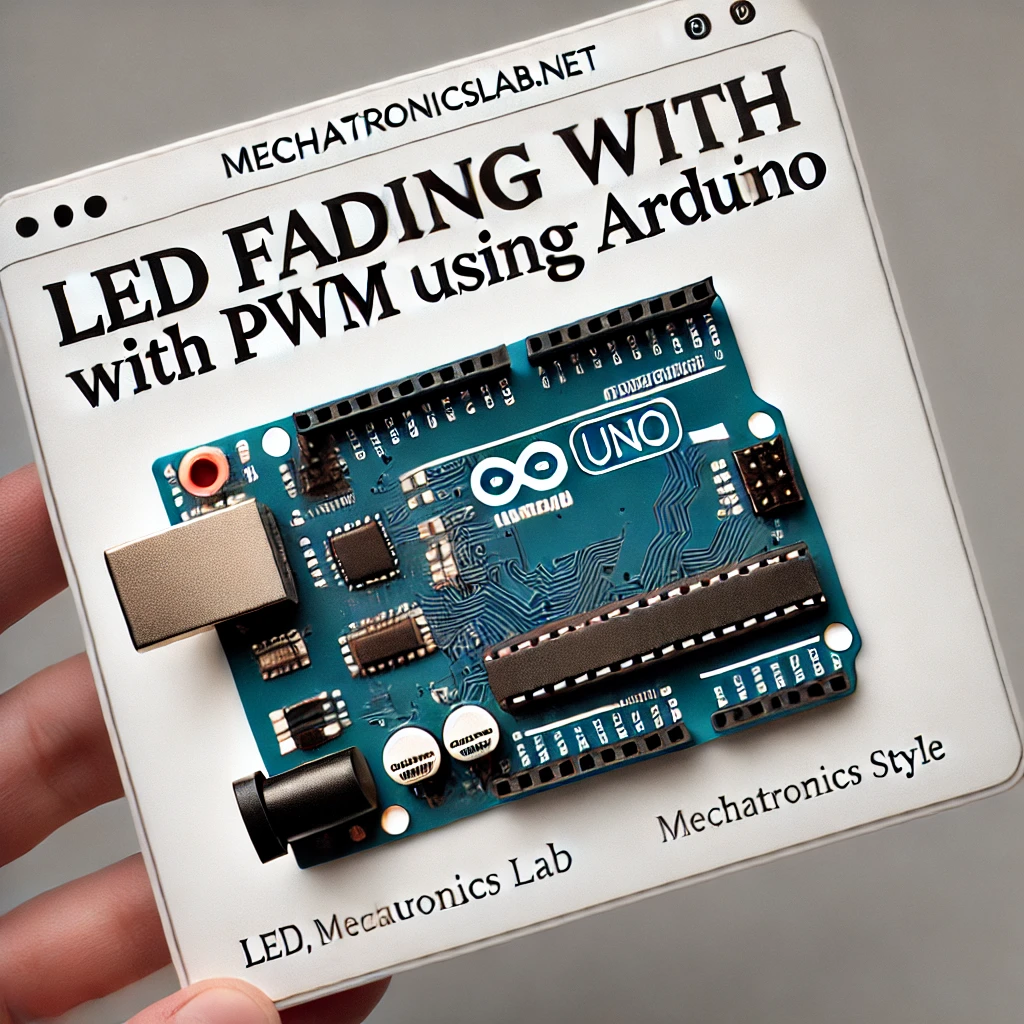Arduino Project, PWM
LED Fading with PWM Using Arduino
The objective of this project is to gradually LED Fading with PWM Using Arduino with Arduino. The project demonstrates how Pulse Width Modulation (PWM) works by adjusting the brightness of the LED in a loop, increasing and decreasing its intensity over time.
Fundamental Programming Concepts
- PWM (analogWrite()): Use PWM to control the brightness of the LED by sending varying signals.
- Timing (delay()): Pause the program for a specified duration to control the speed of the LED’s fading.
- Control Structures (for Loop): Use a for loop to gradually increase and decrease the brightness in steps.
Requirement Components
To complete this LED fading with PWM using Arduino project, you will need:
- Arduino Uno Board
- LED
- 220Ω Resistor
- Breadboard
- Jumper Wires
- USB Cable (for connecting Arduino to your computer)
Circuit Diagram
Circuit Connection
| Component | Arduino Pin |
| LED (Anode) | Pin 9 (PWM Pin) |
| LED (Cathode) | GND |
| 220Ω Resistor | Between LED anode and Pin 9 |
How to Connect the Circuit
- LED: Connect the anode (longer leg) of the LED to Pin 9 on the Arduino (a PWM pin) and the cathode to GND using a 220Ω resistor.
- Power and Ground: Connect the breadboard’s power and ground rails to the Arduino’s 5V and GND pins, respectively.
- Ensure all connections are secure.
Explanation of Circuit
- The LED is connected to Pin 9, which is a PWM pin, allowing the Arduino to control the brightness of the LED using analogWrite().
- The brightness of the LED will increase and decrease gradually by changing the PWM signal sent to the LED in small increments.
Programming Section for LED Fading with PWM Using Arduino
Arduino Syntax
| Topic Name | Syntax | Explanation |
| analogWrite() | analogWrite(pin, value) | Outputs a PWM signal (0-255) to control the brightness. |
| delay() | delay(ms) | Pauses the program for a specified number of milliseconds. |
| For Loop | for(init; condition; increment) | Repeats a block of code for a specified number of steps. |
Arduino Code:
Here’s the Arduino code to fade the brightness of an LED using PWM:
const int ledPin = 9; // Pin connected to the LED (PWM pin)
void setup() {
pinMode(ledPin, OUTPUT); // Set the LED pin as an output
}
void loop() {
// Increase the brightness of the LED
for (int brightness = 0; brightness <= 255; brightness++) {
analogWrite(ledPin, brightness); // Write the PWM signal
delay(10); // Wait for 10ms
}
// Decrease the brightness of the LED
for (int brightness = 255; brightness >= 0; brightness--) {
analogWrite(ledPin, brightness); // Write the PWM signal
delay(10); // Wait for 10ms
}
}Steps to Upload Code:
- Connect your Arduino to your computer using a USB cable.
- Open the Arduino IDE and select the correct Board and Port.
- Copy and paste the provided code into a new sketch.
- Click the Upload button to transfer the code to your Arduino.
- Observe the LED gradually fading in and out as the PWM signal changes.
Check Output
Once the code is uploaded, the LED should smoothly fade in brightness, reaching maximum brightness (255) and then fading down to zero, repeatedly. The speed of the fading is controlled by the delay(10) between each step.
Troubleshooting Tips
- LED not fading? Double-check the connections and ensure the LED is properly connected to Pin 9 (a PWM pin) and GND.
- No output? Verify that the analogWrite() function is sending the correct PWM signal and that the correct pins are being used.
- Fast fading? If the LED is fading too quickly, increase the delay between brightness steps by changing the delay(10) to a higher value, like delay(20).
Further Exploration
- Multiple LEDs: Add more LEDs to different PWM pins and control their brightness individually.
- Change Fading Speed: Experiment with different delay() values to change how fast or slow the LED fades in and out.
- Button-Controlled Fading: Add a button to start and stop the fading effect.
Note
This project demonstrates how PWM can be used to control the brightness of an LED in a smooth, gradual manner. Understanding how to use analogWrite() and for loops is essential for building more advanced projects like motor speed control or dimmable lights.
FAQ
Q1: What is PWM, and how does it control the LED’s brightness?
PWM (Pulse Width Modulation) allows you to control the amount of power supplied to the LED. By changing the pulse width, you can adjust the brightness from 0 (off) to 255 (full brightness).
Q2: How does analogWrite() work in this project?
The analogWrite() function sends a PWM signal to a specific pin, which adjusts the brightness of the LED between 0 and 255.
Q3: Can I change the fading speed?
Yes, by adjusting the delay() value in the code, you can control how fast or slow the LED fades in and out.
Q4: Can I add more LEDs to this project?
Yes, you can connect additional LEDs to other PWM pins (such as Pins 3, 5, 6, 10, or 11) and control their brightness individually.
Q5: What does the for loop do in this project?
The for loop gradually increases and decreases the brightness of the LED by incrementing or decrementing the PWM value.

